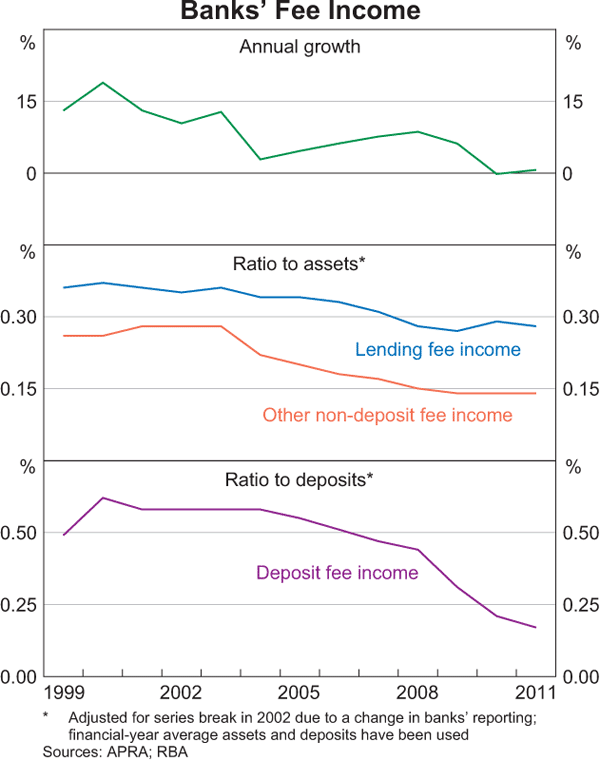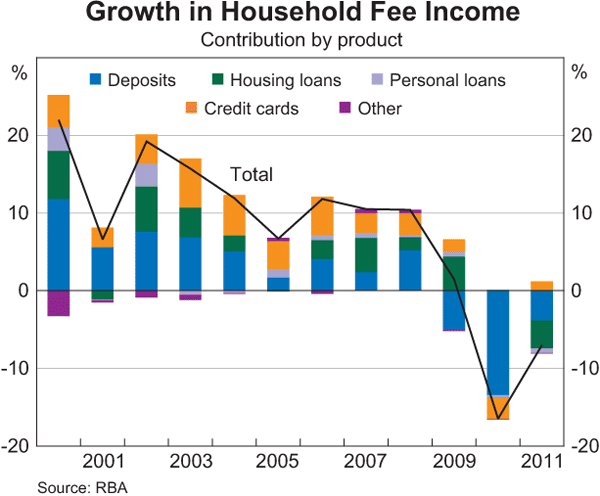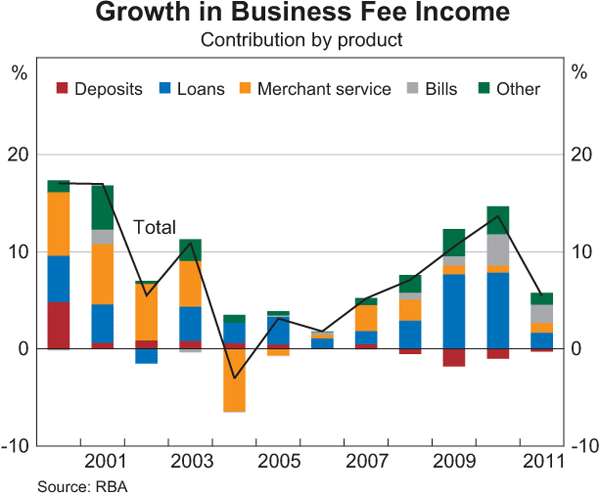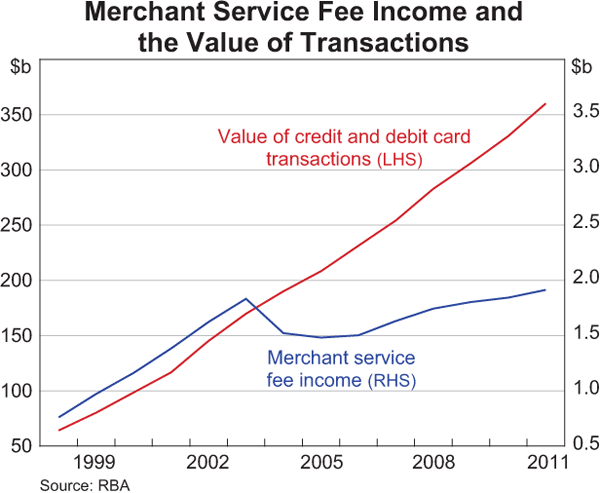Bulletin – June 2012 Banking Fees in Australia
- Download the article 701KB
Abstract
The Reserve Bank has conducted a survey on bank fees each year since 1997. The results of the latest survey show that banks' aggregate fee income rose slightly in the banks' 2011 financial years, but that growth in fee income was less than that in banks' total assets. Fee income from households declined while fee income from businesses grew, largely as a result of increases in fees on business loans and bank bills.
Fees from Banking Activities
The Reserve Bank's annual bank fee survey provides information on the fees that commercial banks earn from their Australian operations.[1] It focuses on fee income generated by banks in the process of taking deposits, making loans and providing payment services. Other forms of non-interest income, such as income earned from funds management and insurance operations, are excluded from the survey. This article summarises the results of the latest survey, which relate to the banks' 2011 financial years.[2] It covers 17 institutions, which together account for around 90 per cent of the total assets of the Australian banking sector.
Total domestic fee income in 2011 grew by 0.7 per cent to $11.3 billion (Graph 1, Table 1). This outcome reflects a number of developments, including:
- a decline in fee income from households, in particular relating to deposits and housing loans;
- an increase in fee income from businesses, particularly fees on loans and bank bill facilities; and
- continued falls in total deposit fee income and little change in total lending fee income.

| Households | Businesses | Total | ||||
|---|---|---|---|---|---|---|
| $ billion | Growth | $ billion | Growth | $ billion | Growth | |
| Per cent | Per cent | Per cent | ||||
| 2008 | 5.1 | 10.4 | 5.5 | 7.1 | 10.6 | 8.7 |
| 2009 | 5.2 | 1.5 | 6.1 | 10.5 | 11.3 | 6.2 |
| 2010 | 4.3 | −16.5 | 6.9 | 13.7 | 11.2 | −0.2 |
| 2011 | 4.0 | −7.0 | 7.3 | 5.5 | 11.3 | 0.7 |
|
Source: RBA | ||||||
Households
Banks' fee income from households declined by 7.0 per cent in 2011, to around $4.0 billion (Graph 2, Table 2). The fall in household fee income was largely a result of declines in both housing loan and deposit fee income and was broad based across surveyed banks. Loan fees currently account for 71 per cent of total household fees, compared with 54 per cent five years ago. Conversely, household deposit fees account for around 27 per cent of total household fees, compared with 44 per cent five years ago.

| 2009 | 2010 | 2011 | Growth 2011 |
Average growth 2005–2010 |
|
|---|---|---|---|---|---|
| $ million | Per cent | Per cent | |||
| Deposits | 1,940 | 1,247 | 1,081 | −13.3 | −6.0 |
| of which: exception fees | 688 | 299 | 172 | −42.5 | na |
| Loans: | 3,137 | 2,981 | 2,849 | −4.4 | 8.8 |
| of which: exception fees | 615 | 370 | 315 | −14.8 | na |
| – Housing | 1,390 | 1,397 | 1,240 | −11.3 | 11.4 |
| – Personal | 343 | 326 | 300 | −7.8 | 4.9 |
| – Credit cards | 1,403 | 1,258 | 1,308 | 4.0 | 7.2 |
| Other fees | 97 | 94 | 91 | −2.8 | 3.1 |
| Total | 5,174 | 4,322 | 4,021 | −7.0 | 2.9 |
| of which: exception fees | 1,303 | 669 | 487 | −27.2 | na |
|
Source: RBA |
|||||
Household deposit fee income declined by 13.3 per cent in 2011, despite continued strong growth in the value of deposits. This fall was largely a result of a decline in exception fees on transaction deposit accounts. Exception fees on deposit accounts include, for example, fees charged when a customer does not have sufficient funds in an account to cover a direct debit payment. Account servicing and transaction fee income on these types of deposit accounts also continued to fall, alongside heightened competition among banks to raise deposit funding. Since peaking in 2008, fees paid by households on transaction accounts – which make up more than 90 per cent of deposit fees paid by households – have halved.
Total fee income earned on housing loans fell by 11.3 per cent in 2011, after having grown at an average annual growth rate of 11.4 per cent between 2005 and 2010. The fall in housing loan fee income occurred despite the surveyed banks' outstanding housing loans growing by 8 per cent. This fall was mainly a result of a decline in account servicing and ‘other’ fee income. Much of this decline owed to falls in exit fees charged by banks for the early termination of variable-rate mortgages. These fees were banned by the Federal Government from 1 July 2011 on new housing loans, although some banks abolished these fees prior to this date. There was also a decline in income from break fees. Break fees are charged by banks when a fixed-rate loan is terminated early by the borrower, as banks incur costs when exiting the swap transactions they undertake to hedge the interest rate risk involved in extending fixed-rate loans. With fewer customers breaking their fixed-rate loans during the banks' 2011 financial years – as the increase in variable rates made it less attractive for households to break their fixed-rate loans and there were fewer of these loans outstanding – fee income from this source fell. A slower rate of housing loan approvals also contributed to lower establishment fee income for some banks.
Total fee income earned on personal loans fell by 7.8 per cent in 2011, notwithstanding a 1 per cent rise in the stock of personal credit for surveyed banks. Fee income from credit cards rose by 4.0 per cent. This was driven by an increase in credit card account servicing fee income based on a small increase in the number of cards on issue. Banks' unit charges on credit cards were, however, little changed (Table 3). The value of transactions and cash advances also both increased over the year.
| Growth 2011 | Average growth 2005–2010 | ||||
|---|---|---|---|---|---|
| 2009 | 2010 | 2011 | Per cent | Per cent | |
| Annual fees ($)(b) | |||||
| No-frills cards | 52 | 53 | 54 | 2.1 | 6.5 |
| Standard cards | 29 | 29 | 29 | 0.0 | 0.6 |
| Standard rewards-based cards | 80 | 80 | 80 | 0.0 | −1.2 |
| Gold rewards-based cards | 140 | 151 | 137 | −9.7 | 2.5 |
| Platinum rewards-based cards | 231 | 283 | 283 | 0.0 | na |
| Cash advance fees(c) | |||||
| Own banks' ATM | |||||
| – $ charge | 1.23 | 1.06 | 1.06 | 0.0 | −4.7 |
| – Per cent of value | 1.6 | 1.8 | 1.8 | 3.6 | 9.2 |
| Other banks' ATM | |||||
| – $ charge | 1.38 | 1.06 | 1.06 | 0.0 | −8.2 |
| – Per cent of value | 1.6 | 1.8 | 1.8 | 3.6 | 4.0 |
| Overseas ATM | |||||
| – $ charge | 3.63 | 3.63 | 3.63 | 0.0 | 0.0 |
| – Per cent of value | 1.7 | 1.7 | 1.8 | 3.7 | 3.3 |
| Foreign currency conversion fee (per cent of value) | 2.6 | 2.6 | 2.9 | 9.6 | 1.5 |
| Late payment fee ($) | 31 | 15 | 14 | −8.5 | −12.5 |
| Over-limit fee ($)(d) | 30 | 14 | 10 | −27.8 | −14.0 |
|
(a) Simple average of fees for credit cards with interest-free periods issued
by major banks, except for the annual fee on no-frills cards, which is
based on a wider sample of banks; note that changes in the sample affect
the average fee Sources: CANSTAR; RBA; credit card issuers' websites |
|||||
Exception fees across all types of household loans continued to fall over the year. These types of exception fees can arise when a customer makes a late payment, or exceeds a credit limit. A continued decline in credit card exception fees drove this result.
Businesses
Banks' fee income earned from businesses increased by 5.5 per cent in 2011 to $7.3 billion (Table 4, Graph 3). Most of the growth in business fee income reflected growth in fees earned on loans and bank bills, and occurred despite lending to businesses falling slightly over the year. Fee income from business loans rose by 4.2 per cent, while fee income from bank bills (which includes charges for arranging bank bill facilities and accepting or endorsing bank bills) rose by 23.2 per cent. The increase in fees on these facilities was largely due to the repricing of establishment fees and line fees, which are charged by banks to maintain credit lines regardless of use. This ongoing repricing largely reflects banks re-evaluating the credit and liquidity risks associated with these facilities, including in the context of the forthcoming Basel III bank capital and liquidity standards. In 2011, fee income earned on business loans and bank bills accounted for just under half of all fee income earned by banks from businesses, compared with around 39 per cent five years ago.

| 2009 | 2010 | 2011 | Growth 2011 | Average growth 2005–2010 |
|
|---|---|---|---|---|---|
| $ million | Per cent | Per cent | |||
| Deposit accounts | 711 | 650 | 631 | −3.0 | −4.3 |
| of which: exception fees | 122 | 59 | 48 | −19.2 | na |
| Loans | 2,254 | 2,733 | 2,848 | 4.2 | 11.8 |
| of which: exception fees | 75 | 53 | 40 | −24.2 | na |
| Bank bills | 365 | 561 | 691 | 23.2 | 16.1 |
| Merchant service fees | 1,796 | 1,839 | 1,910 | 3.9 | 4.4 |
| Other | 963 | 1,138 | 1,221 | 7.3 | 10.9 |
| Total | 6,088 | 6,921 | 7,300 | 5.5 | 7.6 |
| of which: exception fees | 197 | 112 | 88 | −21.6 | na |
|
Source: RBA |
|||||
Fee income earned on business deposits fell by 3.0 per cent in the year, even though business deposit balances increased by 15 per cent. As with household deposits, banks have been competing vigorously for deposits from the business sector. The decline in fee income earned on deposits occurred for both small and large business deposit accounts. Exception fees on deposit accounts continued to fall, largely benefiting small businesses which incur around 85 per cent of total business exception fees. Business deposit fees now make up only 9 per cent of total business fees, down from 17 per cent five years ago.
Merchant service fee income rose by 3.9 per cent in 2011 (Graph 4). These fees are charged by banks for providing merchants with credit and debit card transaction services, with around 70 per cent of these fees paid by small businesses. The increase was largely attributable to higher merchant fee income from credit cards. Since the introduction of the Reserve Bank's credit card interchange reforms in 2003, total merchant service fee income has grown by 5 per cent, despite the value of card transactions more than doubling over this time.

Footnotes
The authors are from Domestic Markets Department. [*]
The data from the survey are published in the Reserve Bank's Statistical Table F6, ‘Domestic Banking Fee Income’. [1]
All data in this article are based on banks' financial years, which differ between banks, apart from Table 3, where data are as at June. [2]